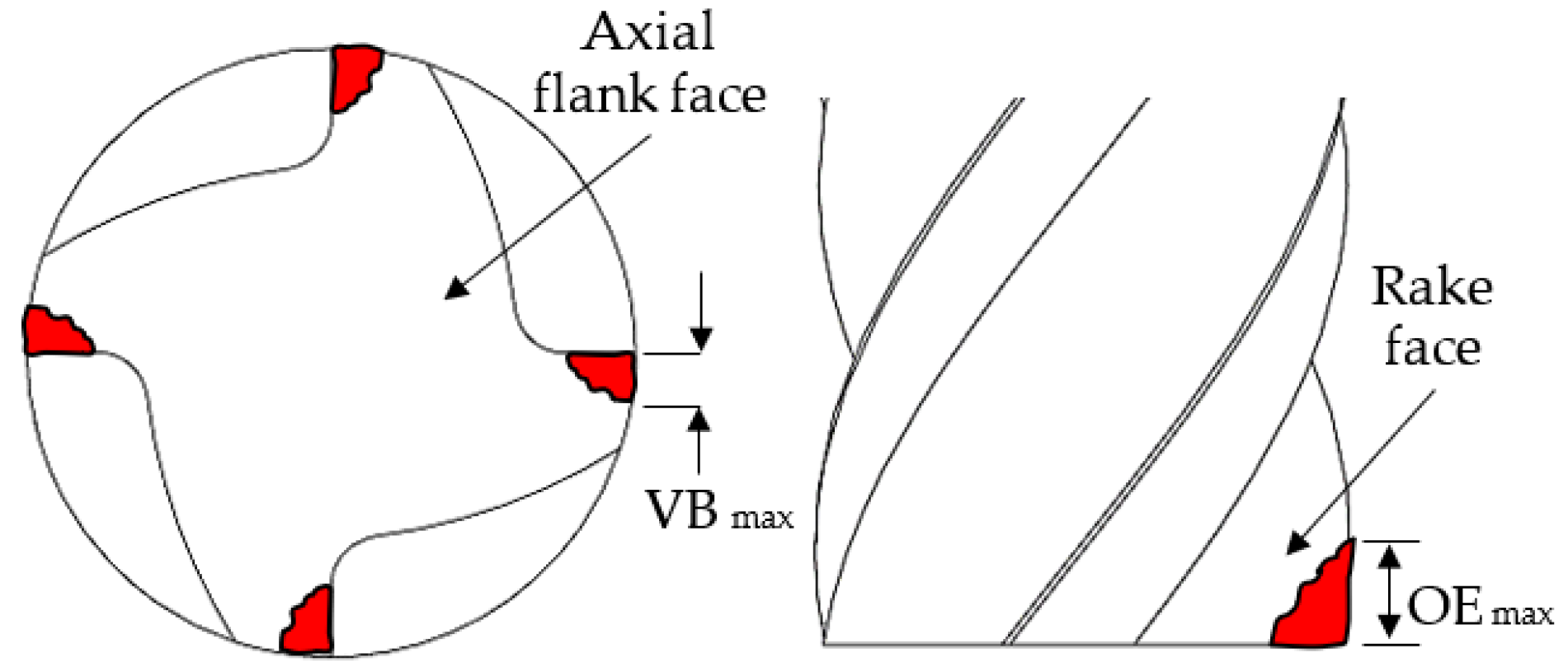Influence of Size Effect in Milling of a Single-Crystal Nickel-Based Superalloy
Abstract
1. Introduction
2. Materials and Methods
3. Results and Discussion
3.1. Chip Formation
3.2. Tool Wear
3.3. Cutting Forces
3.4. Machined Surface Quality
3.5. Burr Formation
4. Conclusions
Author Contributions
Funding
Data Availability Statement
Acknowledgments
Conflicts of Interest
References
- Poyraz, Ö.; Ozaner, O.; Subaşı, L. Comparative review on the manufacturing of turbine blade fir-tree roots. In Proceedings of the 10th International Congress on Machining (UTIS 2019), Antalya, Turkey, 7–9 November 2019; pp. 330–335. [Google Scholar]
- Kyprianidis, K.G. Future aero engine designs: An evolving vision. In Advances in Gas Turbine Technology; Benini, E., Ed.; IntechOpen: London, UK, 2011; pp. 1–24. [Google Scholar]
- Klocke, F.; Klink, A.; Veselovac, D.; Aspinwall, D.K.; Soo, S.L.; Schmidt, M.; Kruth, J.P. Turbomachinery component manufacture by application of electrochemical, electro-physical and photonic processes. CIRP Ann. Manuf. Technol. 2014, 63, 703–726. [Google Scholar] [CrossRef]
- Chandra, S.; Tan, X.; Wang, C.; Yip, Y.H.; Seet, G.; Tor, S.B. Additive manufacturing of a single crystal nickel-based superalloy using selective electron beam melting. In Proceedings of the 3rd International Conference on Progress in Additive Manufacturing (Pro-AM 2018), Nanyang Technological University (NTU), Singapore, 14–17 May 2018; pp. 427–432. [Google Scholar]
- Körner, C.; Ramsperger, M.; Meid, C.; Bürger, D.; Wollgramm, P.; Bartsch, M.; Eggeler, G. Microstructure and mechanical properties of CMSX-4 single crystals prepared by additive manufacturing. Metall. Mater. Trans. A 2018, 49, 3781–3792. [Google Scholar] [CrossRef]
- Sommer, D.; Götzendorfer, B.; Esen, C.; Hellmann, R. Design rules for hybrid additive manufacturing combining selective laser melting and micromilling. Mater. 2021, 14, 5753. [Google Scholar] [CrossRef] [PubMed]
- Balázs, B.Z.; Geier, N.; Takács, M.; Davim, J.P. A review on micro-milling: Recent advances and future trends. Int. J. Adv. Manuf. Technol. 2021, 112, 655–684. [Google Scholar] [CrossRef]
- Serje, D.; Pacheco, J.; Diez, E. Micromilling research: Current trends and future prospects. Int. J. Adv. Manuf. Technol. 2020, 111, 1889–1916. [Google Scholar] [CrossRef]
- Câmara, M.A.; Rubio, J.C.; Abrão, A.M.; Davim, J.P. State of the art on micromilling of materials, a review. J. Mater. Sci. Technol. 2012, 28, 673–685. [Google Scholar] [CrossRef]
- De Oliveira, F.B.; Rodrigues, A.R.; Coelho, R.T.; De Souza, A.F. Size effect and minimum chip thickness in micromilling. Int. J. Mach. Tools Manuf. 2015, 89, 39–54. [Google Scholar] [CrossRef]
- Huo, D.; Cheng, K. Micro Cutting Mechanics. In Micro-Cutting: Fundamentals and Applications; Cheng, K., Huo, D., Eds.; John Wiley & Sons: Oxford, UK, 2013; pp. 19–44. [Google Scholar]
- O’Toole, L.; Kang, C.W.; Fang, F.Z. Precision micro-milling process: State of the art. Adv. Manuf. 2021, 9, 173–205. [Google Scholar] [CrossRef]
- Liang, Z.Q.; Li, S.D.; Zhou, T.F.; Gao, P.; Zhang, D.D.; Wang, X.B. Design and fabrication of a new micro ball-end mill with conical flank face. Int. J. Adv. Manuf. Technol. 2018, 97, 39–50. [Google Scholar] [CrossRef]
- Lee, Y.J.; Wang, H. Current understanding of surface effects in microcutting. Mater. Des. 2020, 192, 108688. [Google Scholar] [CrossRef]
- Chen, N.; Li, H.N.; Wu, J.; Li, Z.; Li, L.; Liu, G.; He, N. Advances in micro milling: From tool fabrication to process outcomes. Int. J. Mach. Tools Manuf. 2021, 160, 103670. [Google Scholar] [CrossRef]
- Vollertsen, F.; Biermann, D.; Hansen, H.N.; Jawahir, I.S.; Kuzman, K. Size effects in manufacturing of metallic components. CIRP Ann. Manuf. Technol. 2009, 58, 566–587. [Google Scholar] [CrossRef]
- Yao, Y.; Zhu, H.; Huang, C.; Wang, J.; Zhang, P.; Yao, P. On the relations between the specific cutting energy and surface generation in micro-milling of maraging steel. Int. J. Adv. Manuf. Technol. 2019, 104, 585–598. [Google Scholar] [CrossRef]
- Aramcharoen, A.; Mativenga, P.T. Size effect and tool geometry in micromilling of tool steel. Precis. Eng. 2009, 33, 402–407. [Google Scholar] [CrossRef]
- Vipindas, K.; Anand, K.N.; Mathew, J. Effect of cutting edge radius on micro end milling: Force analysis, surface roughness, and chip formation. Int. J. Adv. Manuf. Technol. 2018, 97, 711–722. [Google Scholar] [CrossRef]
- Chen, N.; Chen, M.; Wu, C.; Pei, X. Cutting surface quality analysis in micro ball end-milling of KDP crystal considering size effect and minimum undeformed chip thickness. Precis. Eng. 2017, 50, 410–420. [Google Scholar] [CrossRef]
- Mian, A.J.; Driver, N.; Mativenga, P.T. Estimation of minimum chip thickness in micro-milling using acoustic emission. Proc. Inst. Mech. Eng. Part B J. Eng. Manuf. 2011, 225, 1535–1551. [Google Scholar] [CrossRef]
- Alhadeff, L.L.; Marshall, M.B.; Curtis, D.T.; Slatter, T. Protocol for tool wear measurement in micro-milling. Wear 2019, 420, 54–67. [Google Scholar] [CrossRef]
- Mian, A.J.; Driver, N.; Mativenga, P.T. Chip formation in microscale milling and correlation with acoustic emission signal. Int. J. Adv. Manuf. Technol. 2011, 56, 63–78. [Google Scholar] [CrossRef]
- Sahoo, P.; Patra, K.; Szalay, T.; Dyakonov, A.A. Determination of minimum uncut chip thickness and size effects in micro-milling of P-20 die steel using surface quality and process signal parameters. Int. J. Adv. Manuf. Technol. 2020, 106, 4675–4691. [Google Scholar] [CrossRef]
- Liu, Y.; Gong, Y.; Liu, W.; Sun, X.; Xu, L. Effect of milling parameters on chip shape and chip morphology for Zr-based bulk metallic glass by using micro-groove milling. Int. J. Adv. Manuf. Technol. 2020, 111, 1587–1602. [Google Scholar] [CrossRef]
- Xu, K.; Zou, B.; Wang, Y.; Guo, P.; Huang, C.; Wang, J. An experimental investigation of micro-machinability of aluminum alloy 2024 using Ti (C7N3)-based cermet micro end-mill tools. J. Mater. Process. Technol. 2016, 235, 13–27. [Google Scholar] [CrossRef]
- De Oliveira, D.; Gomes, M.C.; De Oliveira, G.V.; Dos Santos, A.G.; Da Silva, M.B. Experimental and computational contribution to chip geometry evaluation when micromilling Inconel 718. Wear 2021, 476, 203658. [Google Scholar] [CrossRef]
- Mian, A.J.; Driver, N.; Mativenga, P.T. Identification of factors that dominate size effect in micro-machining. Int. J. Mach. Tools Manuf. 2011, 51, 383–394. [Google Scholar] [CrossRef]
- Zhou, Y.; Li, H.; Ma, L.; Chen, J.; Tan, Y.; Yin, G. Study on hole quality and surface quality of micro-drilling nickel-based single-crystal superalloy. J. Braz. Soc. Mech. Sci. Eng. 2020, 42, 341. [Google Scholar] [CrossRef]
- Zhou, Y.; Gong, Y.; Zhu, Z.; Gao, Q.; Wen, X. Modelling and optimisation of surface roughness from microgrinding of nickel-based single crystal superalloy using the response surface methodology and genetic algorithm. Int. J. Adv. Manuf. Technol. 2016, 85, 2607–2622. [Google Scholar] [CrossRef]
- Zhu, X.X.; Wang, W.H.; Jiang, R.S.; Zhang, Z.F.; Huang, B.; Ma, X.W. Research on ultrasonic-assisted drilling in micro-hole machining of the DD6 superalloy. Adv. Manuf. 2020, 8, 405–417. [Google Scholar] [CrossRef]
- Gao, Q.; Chen, X. Experimental research on micro-milling force of a single-crystal nickel-based superalloy. Int. J. Adv. Manuf. Technol. 2019, 102, 595–604. [Google Scholar] [CrossRef]
- Gao, Q.; Guo, G.Y.; Cai, M. Wear mechanism and experimental study of a tool used for micro-milling single-crystal nickel-based superalloys. Int. J. Adv. Manuf. Technol. 2021, 113, 117–129. [Google Scholar] [CrossRef]
- Gao, Q.; Gong, Y.; Zhou, Y.; Wen, X. Experimental study of micro-milling mechanism and surface quality of a nickel-based single crystal superalloy. J. Mech. Sci. Technol. 2017, 31, 171–180. [Google Scholar] [CrossRef]
- Szczotok, A.; Chmiela, B. Effect of heat treatment on chemical segregation in CMSX-4 nickel-base superalloy. J. Mater. Eng. Perform. 2014, 23, 2739–2747. [Google Scholar] [CrossRef]
- Nörtershäuser, P.; Frenzel, J.; Ludwig, A.; Neuking, K.; Eggeler, G. The effect of cast microstructure and crystallography on rafting, dislocation plasticity and creep anisotropy of single crystal Ni-base superalloys. Mater. Sci. Eng. A 2015, 626, 305–312. [Google Scholar] [CrossRef]
- ISO 8688-2; International Standards Organisation, ISO 8688-2: Tool Life Testing in Milling—Part 2: End Milling. ISO: Geneva, Switzerland, 1989.
- Tschätsch, H. Applied Machining Technology; Springer: Berlin/Heidelberg, Germany, 2009; pp. 178–184. [Google Scholar]
- M’Saoubi, R.; Axinte, D.; Soo, S.L.; Nobel, C.; Attia, H.; Kappmeyer, G.; Sim, W.M. High performance cutting of advanced aerospace alloys and composite materials. CIRP Ann. Manuf. Technol. 2015, 64, 557–580. [Google Scholar] [CrossRef]
- Ucun, I.; Aslantas, K.; Bedir, F. An experimental investigation of the effect of coating material on tool wear in micro milling of Inconel 718 super alloy. Wear 2013, 300, 8–19. [Google Scholar] [CrossRef]
- Chen, L.; Deng, D.; Pi, G.; Huang, X.; Zhou, W. Burr formation and surface roughness characteristics in micro-milling of microchannels. Int. J. Adv. Manuf. Technol. 2020, 111, 1277–1290. [Google Scholar] [CrossRef]

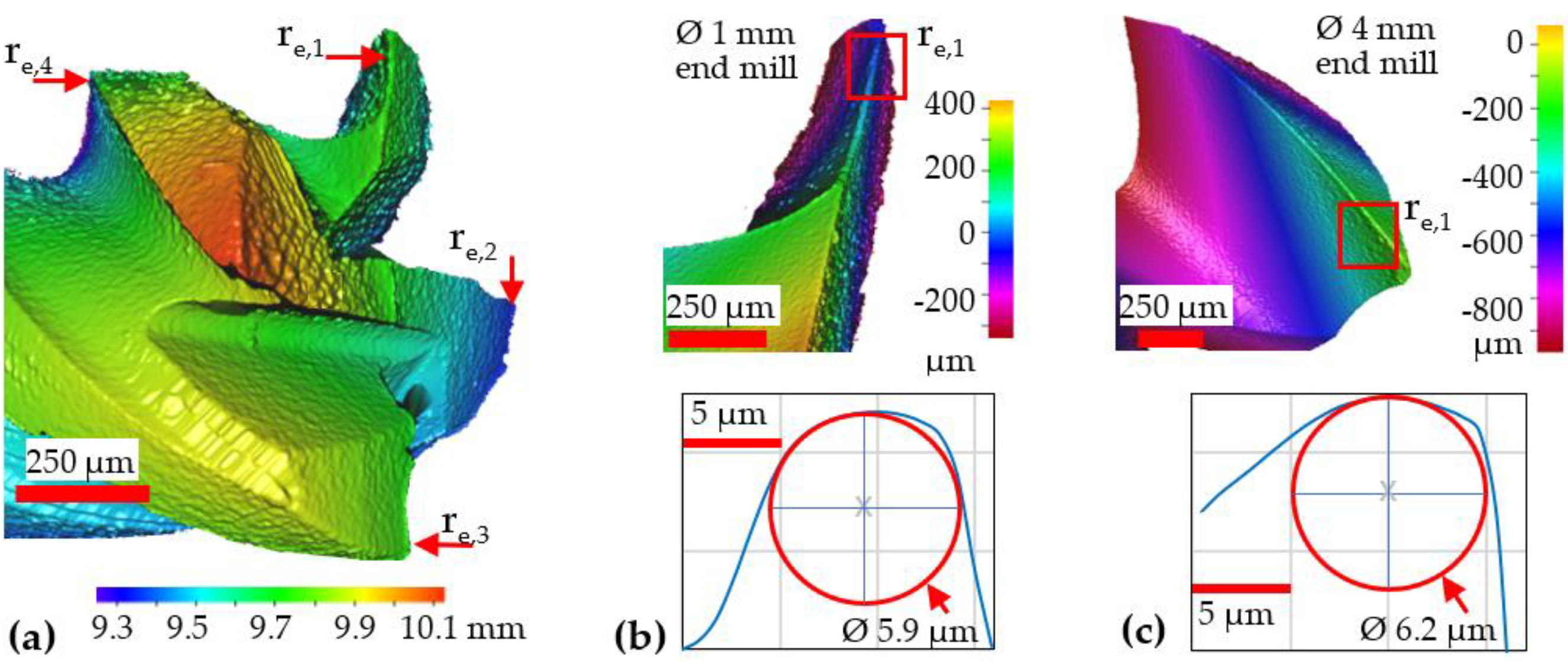
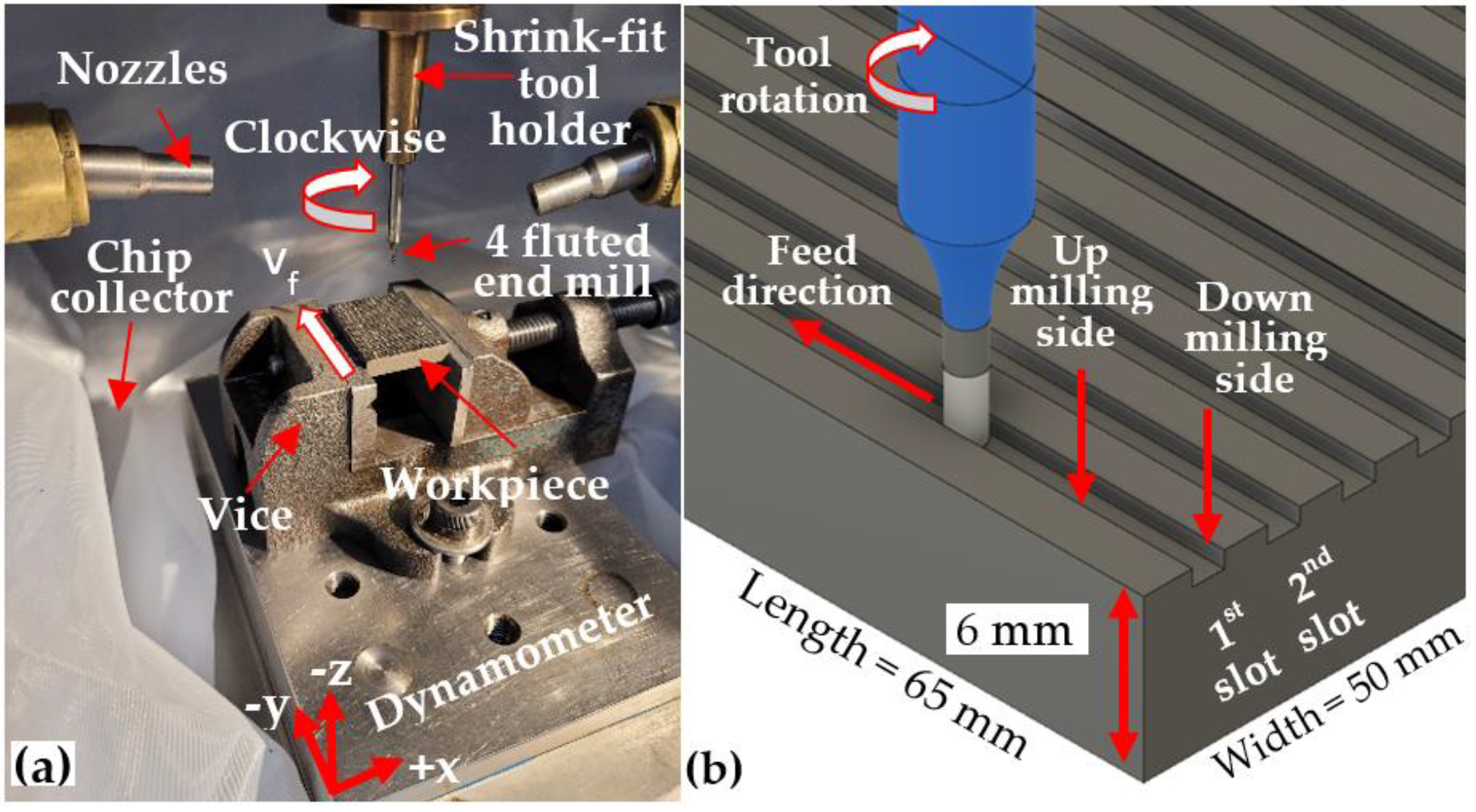
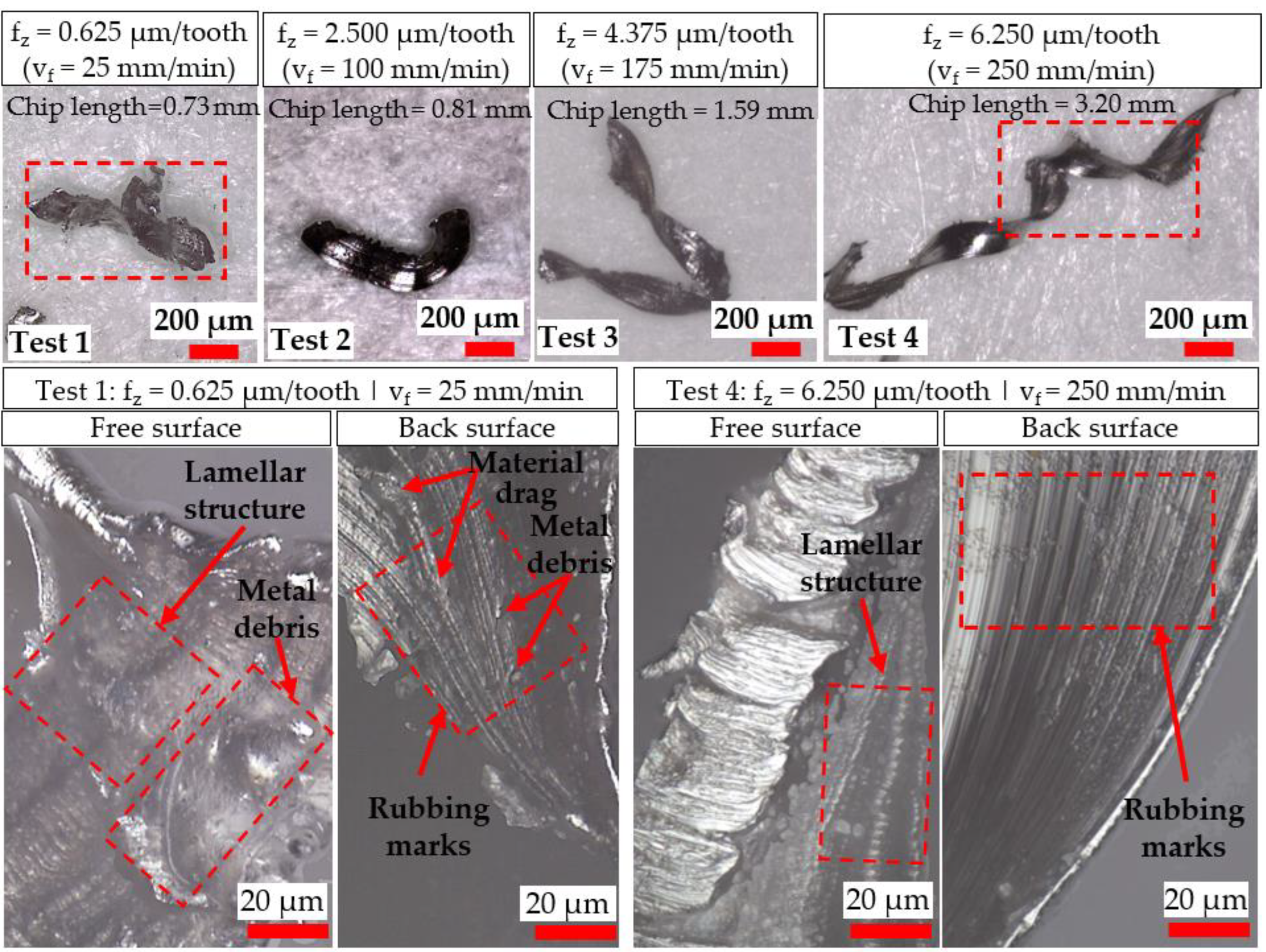
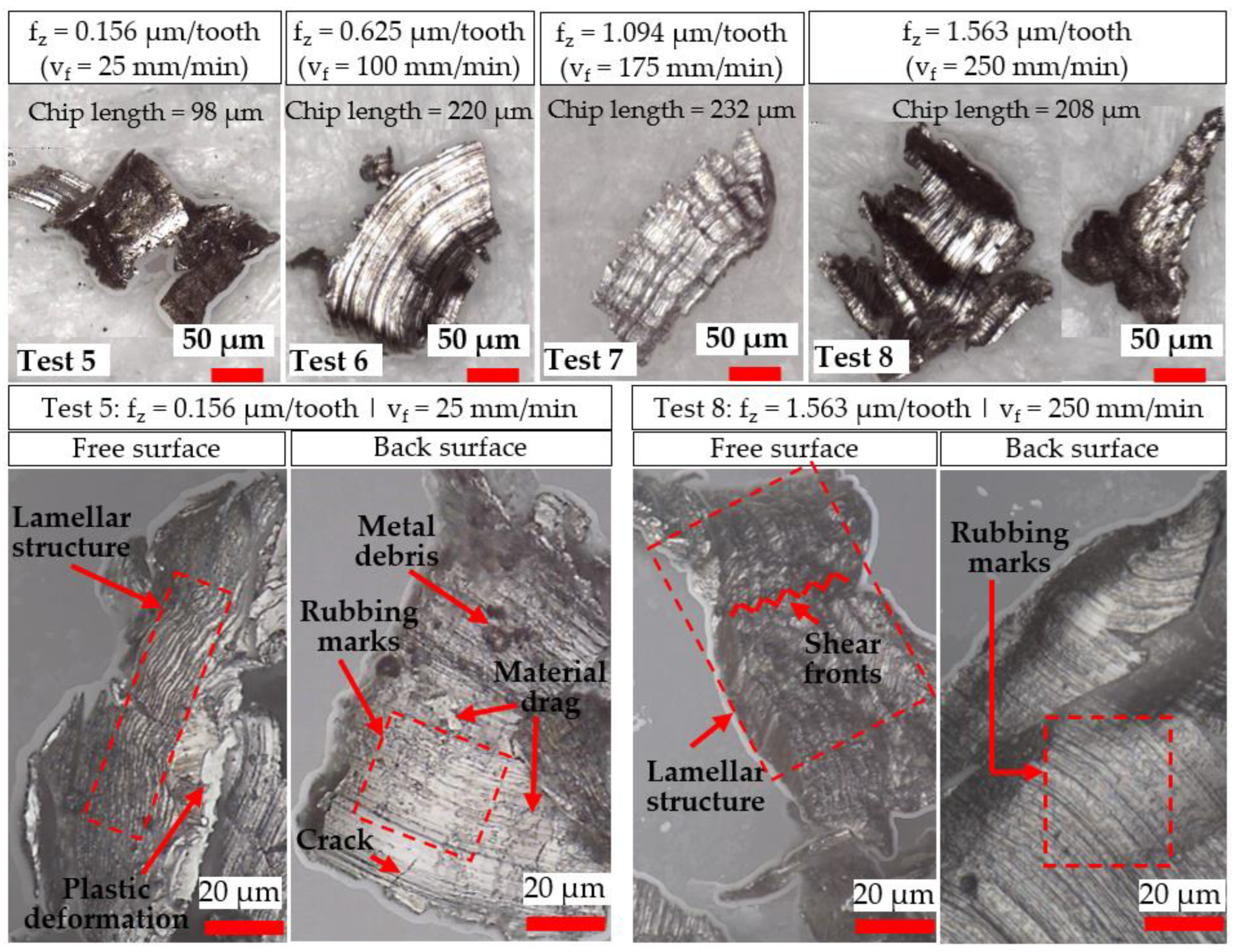
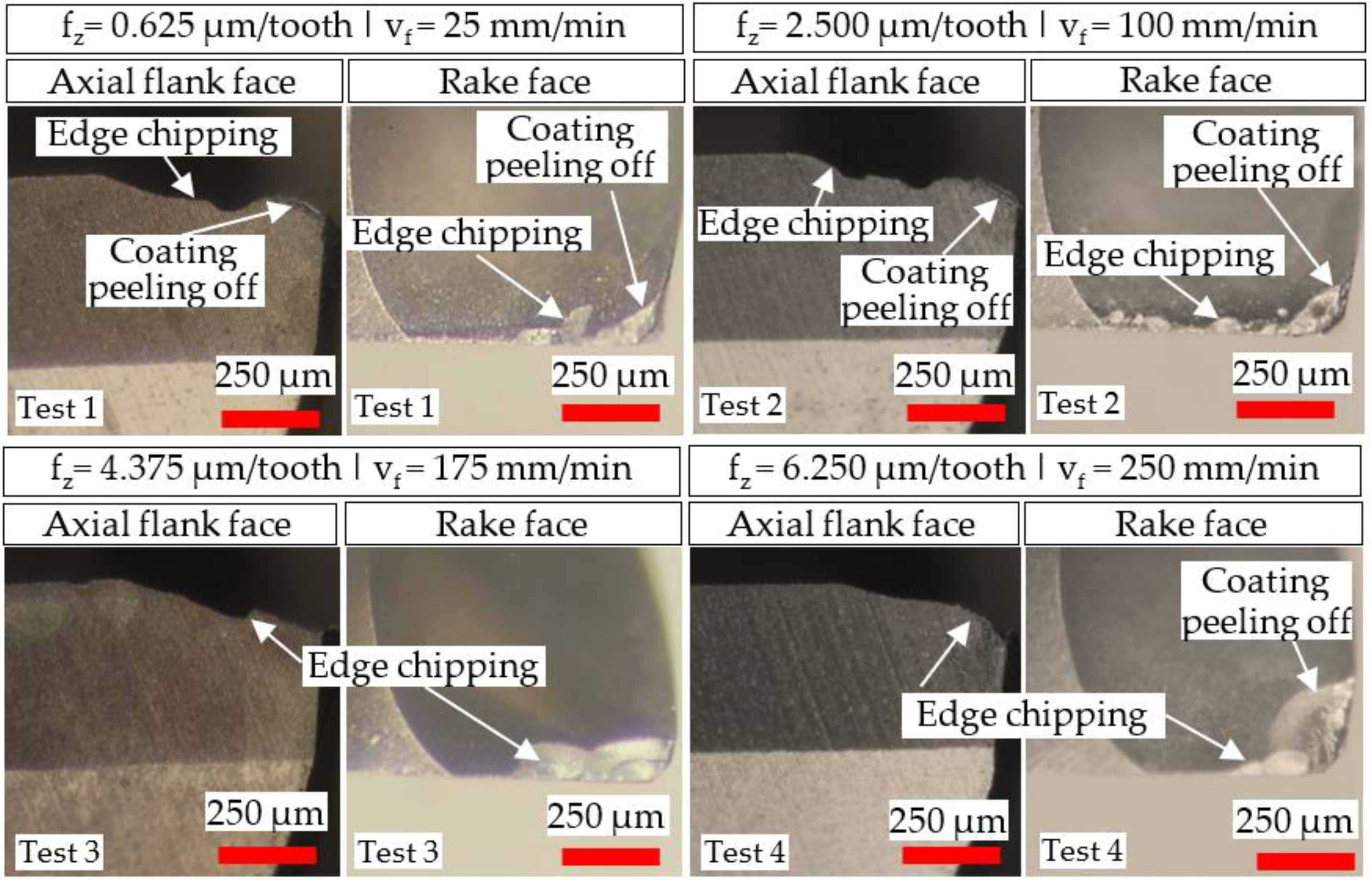
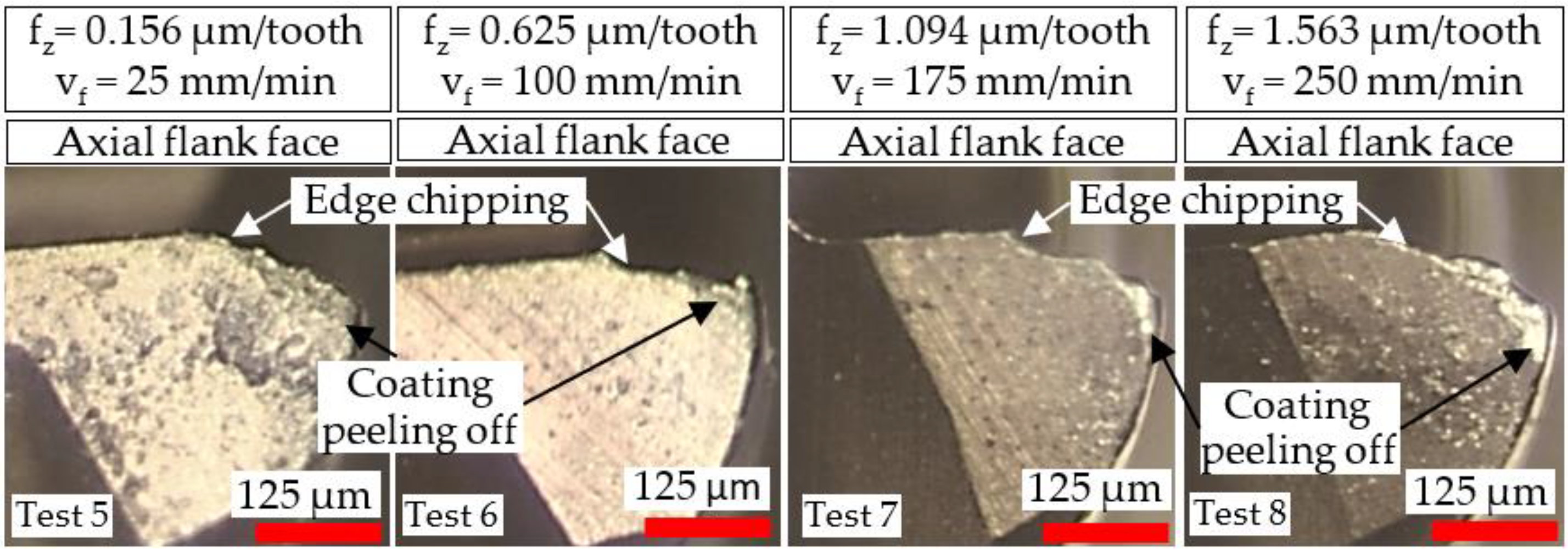
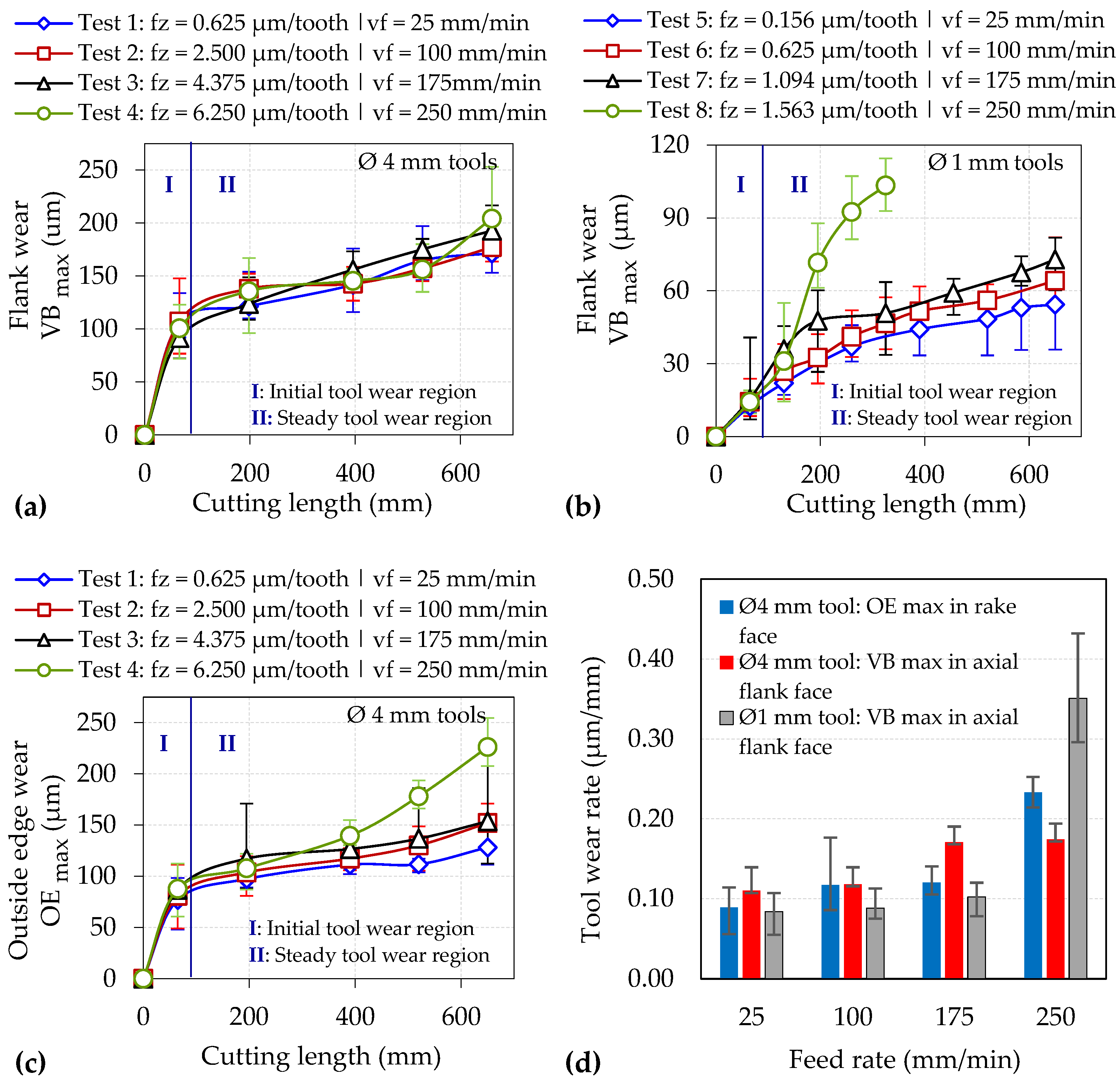
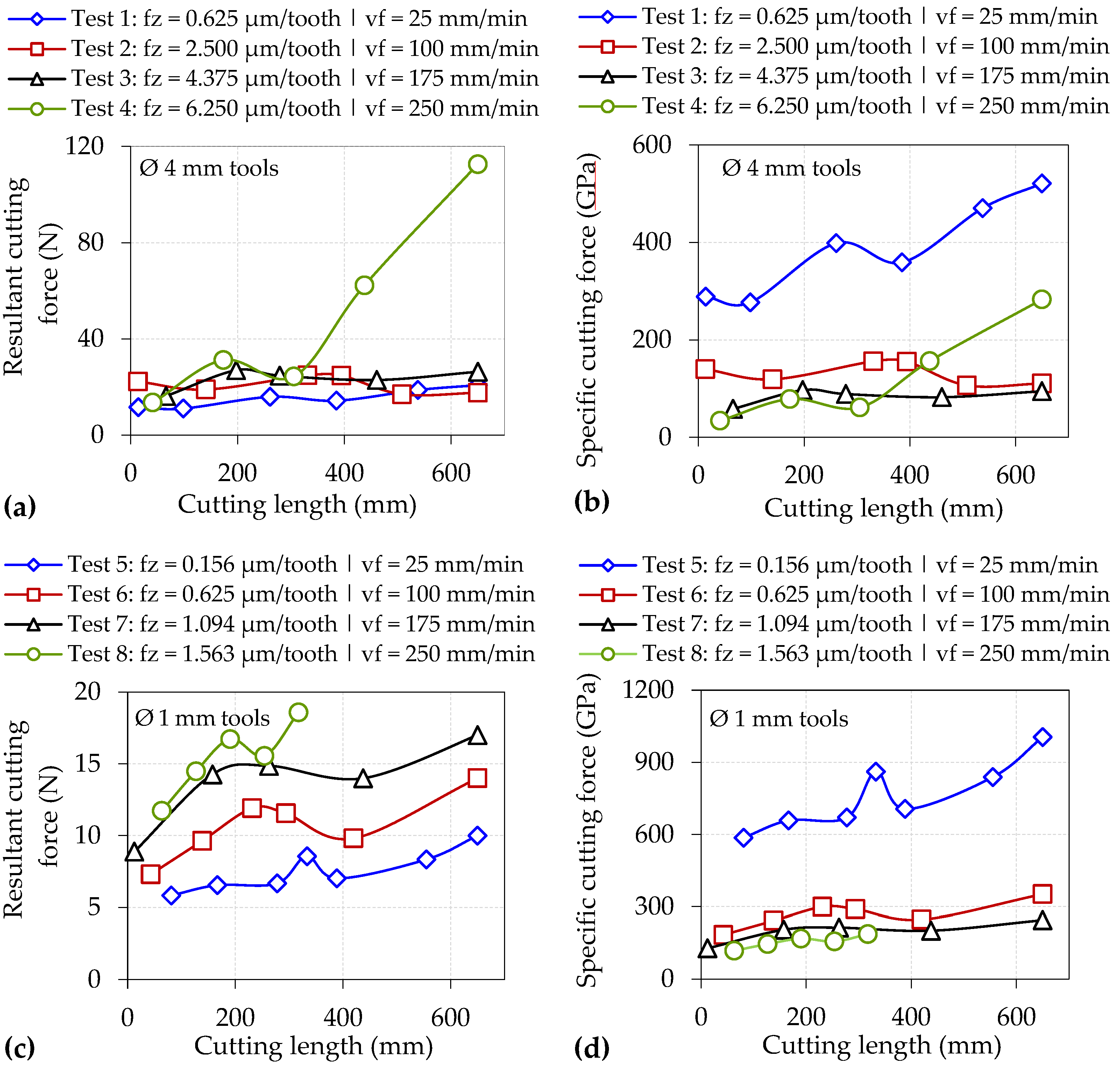
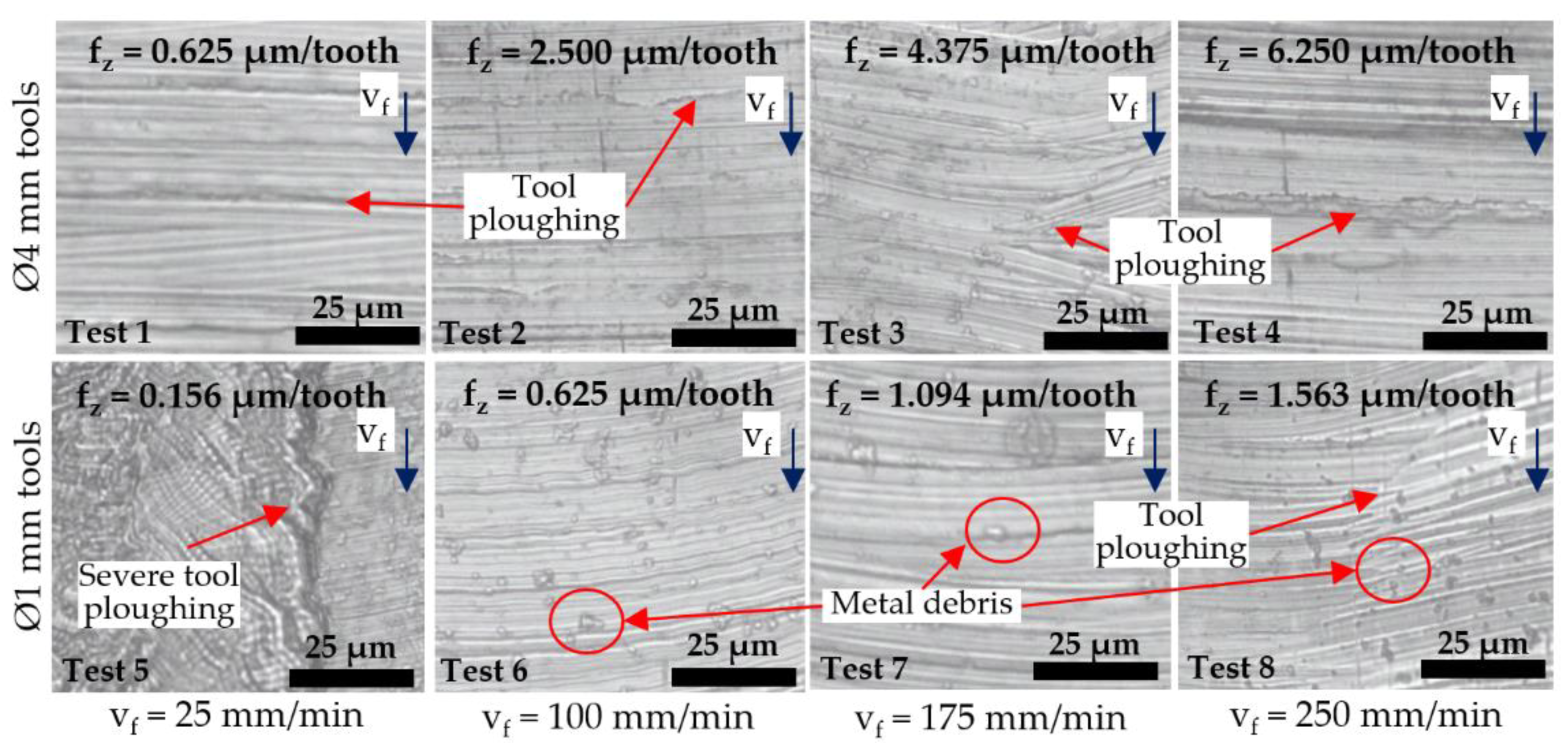


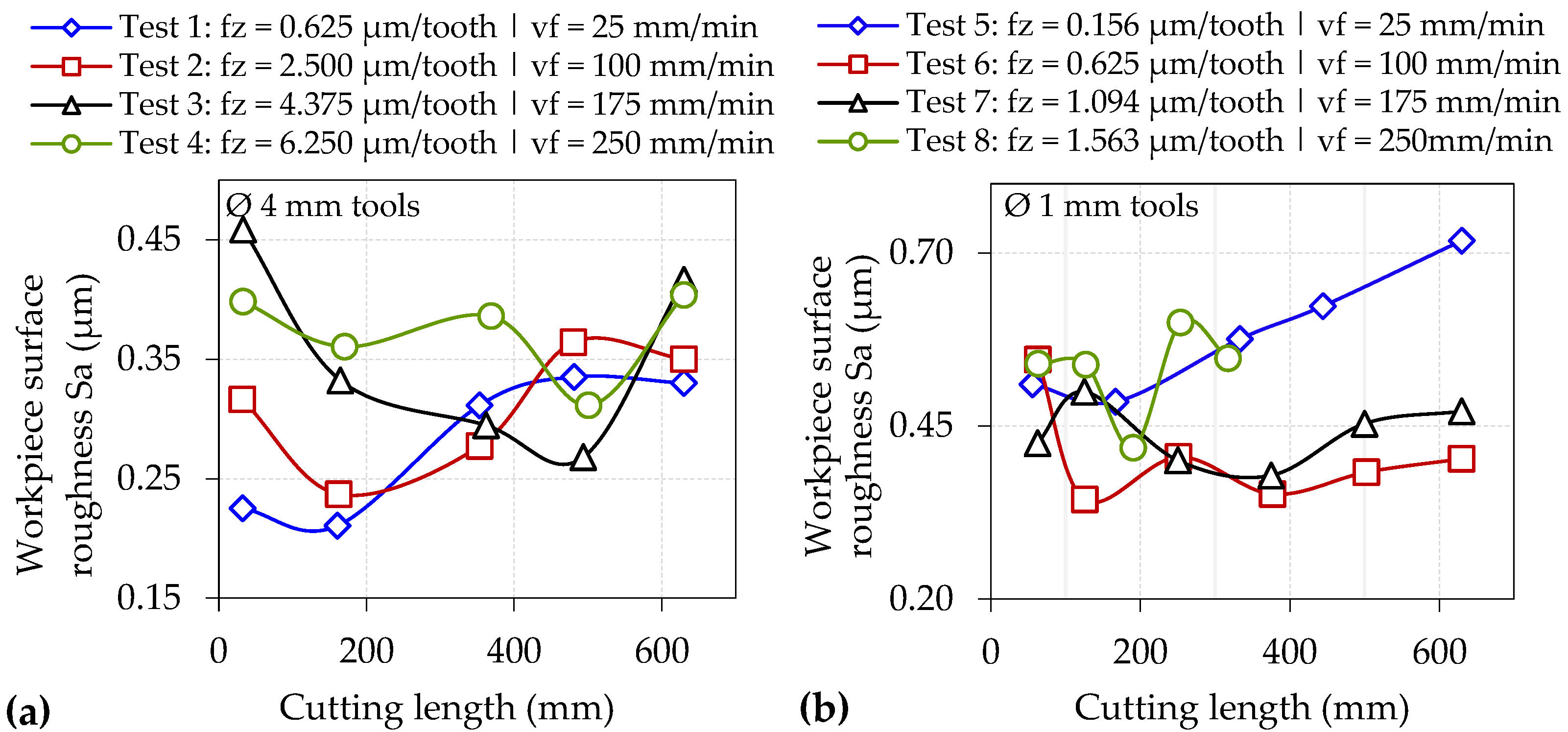
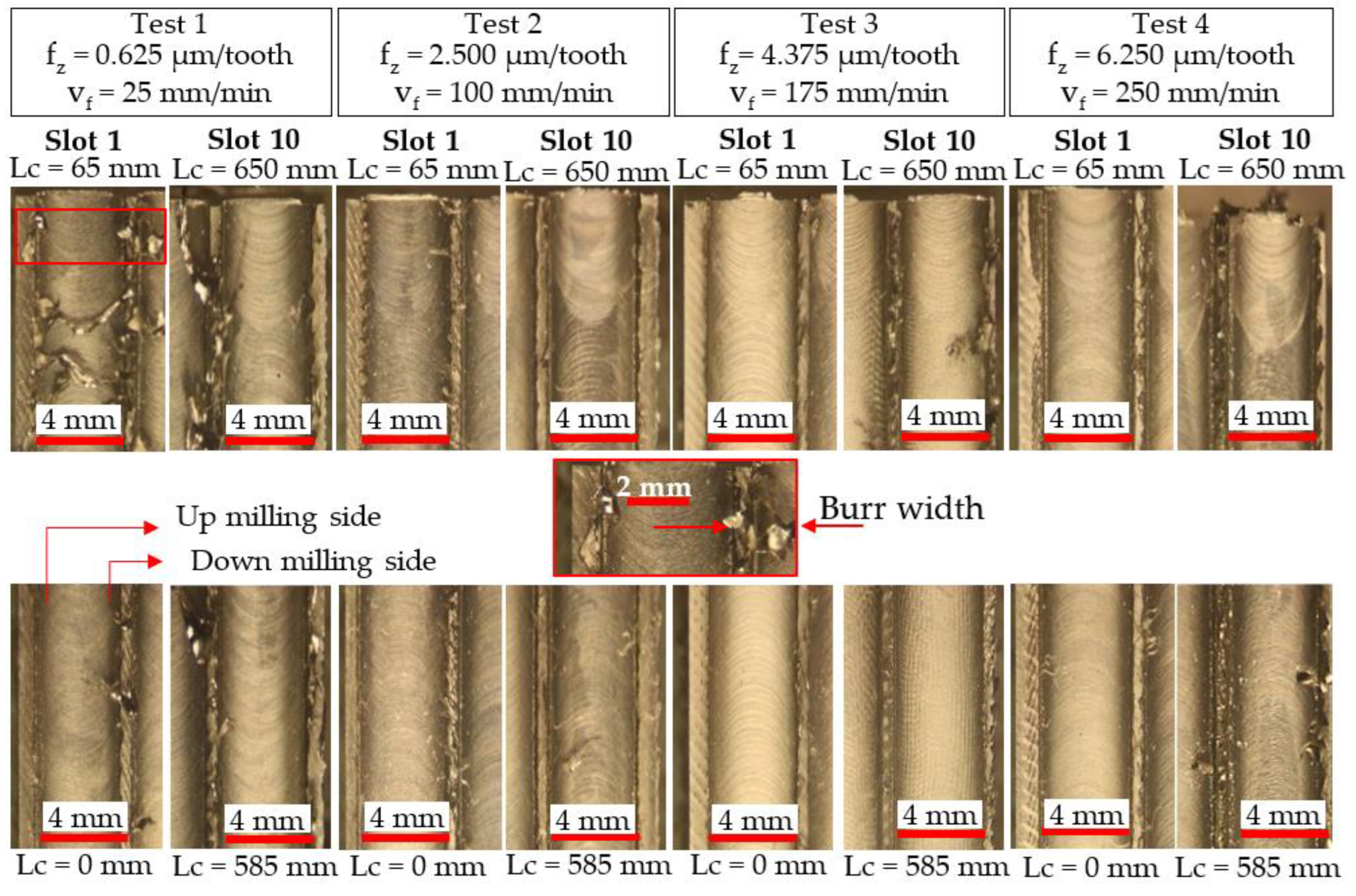

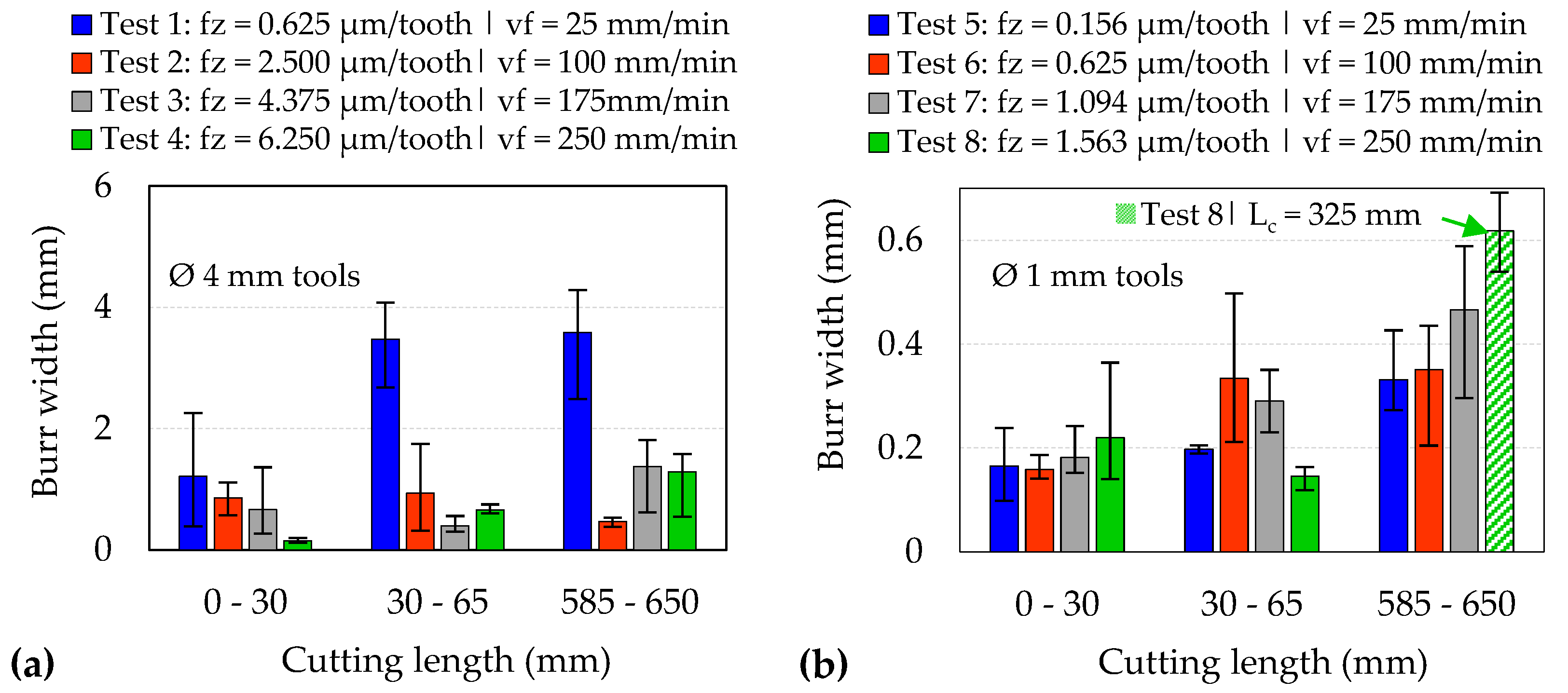
| Cr | Co | Mo | W | Al | Ti | Ta | Re | Hf | Ni |
|---|---|---|---|---|---|---|---|---|---|
| 6.5 | 9.0 | 0.6 | 6.0 | 5.6 | 1.0 | 6.5 | 3.0 | 0.1 | Bal |
| Test No. | Tool Diameter, Ø (mm) | Cutting Speed, vc (m/min) | Feed Rate, vf (mm/min) | Feed per Tooth, fz (μm/Tooth) | fz/re |
|---|---|---|---|---|---|
| 1 | 4 | 126 (10,000 rpm) | 25 | 0.625 | 0.104 |
| 2 | 100 | 2.500 | 0.417 | ||
| 3 | 175 | 4.375 | 0.729 | ||
| 4 | 250 | 6.250 | 1.042 | ||
| 5 | 1 | 126 (40,000 rpm) | 25 | 0.156 | 0.026 |
| 6 | 100 | 0.625 | 0.104 | ||
| 7 | 175 | 1.094 | 0.182 | ||
| 8 | 250 | 1.563 | 0.261 |
Disclaimer/Publisher’s Note: The statements, opinions and data contained in all publications are solely those of the individual author(s) and contributor(s) and not of MDPI and/or the editor(s). MDPI and/or the editor(s) disclaim responsibility for any injury to people or property resulting from any ideas, methods, instructions or products referred to in the content. |
© 2023 by the authors. Licensee MDPI, Basel, Switzerland. This article is an open access article distributed under the terms and conditions of the Creative Commons Attribution (CC BY) license (https://creativecommons.org/licenses/by/4.0/).
Share and Cite
Soriano Gonzalez, L.; Medina Aguirre, F.; Soo, S.L.; Hood, R.; Novovic, D. Influence of Size Effect in Milling of a Single-Crystal Nickel-Based Superalloy. Micromachines 2023, 14, 313. https://doi.org/10.3390/mi14020313
Soriano Gonzalez L, Medina Aguirre F, Soo SL, Hood R, Novovic D. Influence of Size Effect in Milling of a Single-Crystal Nickel-Based Superalloy. Micromachines. 2023; 14(2):313. https://doi.org/10.3390/mi14020313
Chicago/Turabian StyleSoriano Gonzalez, Luis, Fernanda Medina Aguirre, Sein Leung Soo, Richard Hood, and Donka Novovic. 2023. "Influence of Size Effect in Milling of a Single-Crystal Nickel-Based Superalloy" Micromachines 14, no. 2: 313. https://doi.org/10.3390/mi14020313
APA StyleSoriano Gonzalez, L., Medina Aguirre, F., Soo, S. L., Hood, R., & Novovic, D. (2023). Influence of Size Effect in Milling of a Single-Crystal Nickel-Based Superalloy. Micromachines, 14(2), 313. https://doi.org/10.3390/mi14020313






